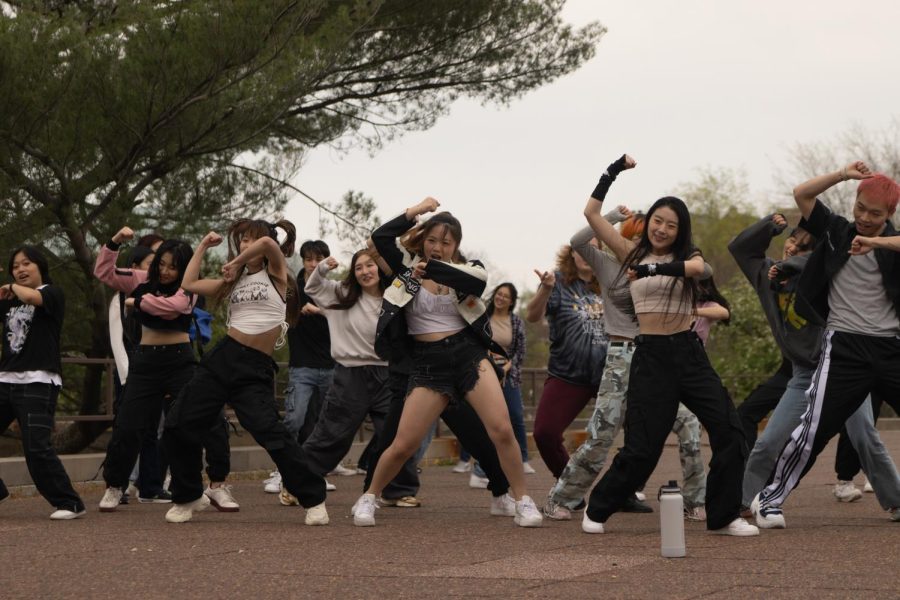Unraveling the history of Asian Americans at UI
Members of the K-pop Dance groups TNB, K Project and Choom participate in a Random Play Dance outside of the Krannert Center for Performing Arts on Friday.
Apr 26, 2023
According to the National Center for Education Statistics, in 2018, the college enrollment rate among 18 to 24-year-olds Asian Americans was 59%, the highest when compared to other racial and ethnic groups.
Statistically and historically, because Asian Americans are “overrepresented” in higher education, they are an invisible minority, said Sharon Lee, assistant professor in Education.
Lee is a graduate of the College of Education and her book, “An Unseen Unheard Minority,” discusses the history of Asian American students at the University of Illinois.
According to Lee, colleges presume that Asian American students face no challenges because they examine “standard educational measures,” overlooking the racial and cultural needs of Asian American students.
“In the aggregate, Asian Americans do quite well, but there’s a lot of complexity because it’s so diverse,” Lee said. “There are still a lot of experiences happening on campus that were still very racialized and hostile to Asian American students.”
Get The Daily Illini in your inbox!
In the 1960s, as part of the Civil Rights Movement, many minority student service programs were developed, Lee explained.
The University of Illinois, similar to many other universities at the time, “did a lot of specific outreach for African American and Latinx students, because when they looked at admission rates, they were much lower than the representation in the state of Illinois,” Lee said.
The Immigration and Nationality Act of 1965 saw an influx of Asian immigrants, most of whom were college educated. By the 1980s, Asian Americans were “removed from those minority protections because (of) the demographic growth of Asian American students” on campuses.
In the 1980s and 1990s at the University of Illinois, Asian American students sought each other out to form organizations such as the Asian American Association and other ethnic groups, Lee said.
“With the rise of multiculturalism, these groups started to come together to really start (engaging in) advocacy issues,” Lee said. “(They advocated) for resources outside of what currently existed.”
The students hoped to accomplish two things — the creation of Asian American studies classes and a cultural center. For the movement, they organized conferences and events as well as created petitions.
The Asian Americans Studies program came first in 1997. Lee notes that the program has grown greatly since then.
“There’s an Asian studies department now, which you could major in as well as minor … so it’s exponentially grown,” Lee said.
The push for an Asian American Cultural Center at the University came later, and “after multiple iterations of students really advocating for it over and over again,” the center was established in 2005, providing Asian American students with their own space to gather and share their experiences.
Rather than focusing on statistical parity, Lee believes that institutions should examine other factors, such as the resources provided, the “campus climate” and “qualitative experiences that students are having.”
Lee also discussed recent issues within the Asian American community, specifically the rise in anti-Asian violence following the pandemic.
She said that the violence “was not a surprise” because “there have always been waves of anti-Asian violence in times of stress.” She cited the internment of Japanese Americans during World War II, the uptick in violence against “anyone seen as South Asian, Arab or Muslim” after 9/11 and modern-day anti-Chinese rhetoric.
“It’s this theme that … Asian Americans (are) not being seen as Americans,” Lee said. “Even if you’ve been here for generations and generations, there’s always the suspicion … that you have an allegiance somewhere else.”
However, Lee said the response to the violence has resulted in greater awareness because “there’s been a lot of multiracial support for Asian Americans to say (hate) is wrong.”
She emphasized that such events demonstrate the necessity of Asian American studies programs in higher education. She believes education plays a key role in dispelling stereotypes and was a contributor to the Teaching Equitable Asian American Community History Act amended to the Illinois Student Code in 2021.
According to the Illinois State Board of Education, the act aims to “ensure that students in every public elementary and high school in Illinois learn about the contributions of Asian Americans to the economic, cultural, social and political development of the United States.”
The program launched first during the 2022-23 school year and developed “resources for teachers to make sure they include accurate representations of Asian American history,” Lee said.
Today, almost 40% of students at the University are of Asian descent, including Asian American and Asian international students, according to the Office of Inclusion and Intercultural Relations.
The Asian American Association still exists today. Lisa Kwan, sophomore in LAS and AAA board member, said the RSO “seeks to foster meaningful relationships by organizing initiatives that facilitate connections” among Asian American students.
“Through hosting diverse events, we strive to build a welcoming community, encourage cultural exploration, unite people toward a philanthropic goal and help others find their footing in the large Asian American community on campus,” Kwan said.






